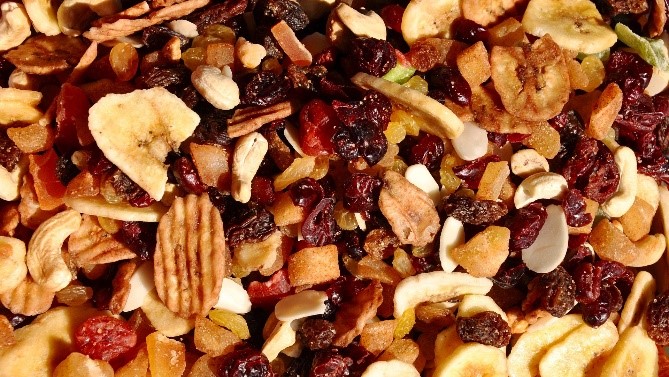
- Dried fruits, nuts, and seeds are products that naturally have a low moisture content after ripening. Dried fruits, nuts, and seeds are products that their natural moisture content after ripening is naturally high, and much of this moisture is removed by drying in a variety of ways.
Definitions and differences between dry and dried
Scientific definitions of each dried fruit
It is obtained by drying the ripe and healthy fruit of the apricot tree with the scientific name of Prunus armeniaca Linnaeus from the Rosaceae family, which has been divided in two halves in the direction of its natural groove and nucleated.
Peach leaf
It is obtained by drying the ripe and healthy fruit of the peach tree with the scientific name of Prunus persica Linnaeus from the Rosaceae family, which has been divided in two halves in the direction of its natural groove and nucleated.
Kiwi leaf
It is obtained from drying and healthy fruit of different cultivars of kiwi shrub with scientific name Actinidia deliciosa var indorus H. jacq from Actinidiaceae family in different forms.
Dried apples
It is obtained by drying the ripe and healthy fruit of the apple tree with the scientific name of Malus pumila P. Miller from the
Rosaceae family in various forms such as halves, leaves, slices, cubes, etc.
Dried cherries
It is obtained by drying the ripe and healthy fruit of the cherry tree with the scientific name of Prunus avium linnaeus from the Rosacea family.
Dried plums
It is obtained by drying the ripe and healthy fruit of the prune tree with the scientific name of Prunus domestica linnaeus from the Rosaceae family.
Dried pears
They are obtained by drying the ripe and healthy fruit of a pear tree with the scientific name of Pyrus communis linnaeus from the Rosaceae family in various forms such as halves, leaves, slices, cubes, etc.
Dried Qaisi
It is obtained by drying the ripe and healthy fruit of a transplanted apricot tree with the scientific name Prunus armeniaca linnaeus from the Rosaceae family.
Dried figs
It is obtained by drying the ripe and healthy fruit of the fig tree with the scientific name Ficus carica linnaeus from the Moraceae family.
Dried pomegranate seeds (pomegranate seeds)
It is obtained by drying the ripe and healthy seeds of different cultivars of pomegranate tree with the scientific name of Punica granatum linnaeus from the Punicaceae family.

Dried berries
It is obtained by drying the ripe and healthy fruit of the berry tree with the scientific name Morus alba linnaeus from the Moraceae family.
Dried cherries
It is produced by drying the healthy and ripe fruit of the cherry tree, scientifically known as Cerasus vulgaris mill (also known as Prunus cerasus) from the Rosaceae family.
Barberry
Dried fruit of Berberis vulgaris l. It belongs to the Berberiaceae family.
Elaeagnus
Ripe fruit is a plant with the scientific name of Elaeagnus angustifolia. From the family Elaeagnaceae, which is seen in the form of a shrub or tree.
chickpeas
Seed Chickpea plant with the scientific name of Cicer arietinum l. From the Leguminoceae family, which is obtained from the initial heating, moistening, reheating and peeling of chickpeas.
Processed chickpeas
Chickpea is to which salt and permitted additives have been added in a proper and hygienic ways. Its color is usually darker than the color of pea and tends to be light brown.
Jujube
It is the fruit of the Zizyphus vulgaris tree and belongs to the Rhamnaceae family.
raisins
The ripe and dried fruit of different cultivars of grapes (hair) are seeded and seedless of Vitis vinifera species of Vitaceae family, which is according to the grape cultivar, drying method and conditions and permitted additives are called as follows.
Sultana seedless raisins
The ripe fruit of Various cultivars, that are allowed to soak in alkaline solutions and dried in the sun. The color of this type of raisin varies from light yellow to palm brown.
Golden seedless raisins
Rriped fruits of different varieties of raisins that have been dried by direct sunlight. The color of this type of raisin is brown.
Sultana seeded raisins
Riped fruits of various cultivars of grained grapes that have been soaked in alkaline solutions and dried in the sun. The color of this type of raisin varies from light yellow to date brown.
Golden raisins
Riped fruit Various cultivars of seeded grapes that have been dried by direct sunlight. The color of this type of raisin is brown.
Grape Raisins (California )
Dried fruits of different grape cultivars, usually from seedless cultivars, that are soaked in sulfur fumes (SO2) ,after drying in permissible alkaline solutions and dried in the shade.
The color of this type of amber is yellowish green.
Currant
Various grape-seeded cultivars, usually cultivars with large, black fruits that have been dried in direct sunlight. The color of this type of raisin is black.
Walnut
The fruit of the walnut tree with the scientific name Juglans regia l. From the Juglandaceae. family
Walnut Kernel
The kernel of a walnut tree fruit with a hard outer skin peeled off.
Apricot kernel
The kernel of the fruit of the apricot tree with the scientific name Prunus armeniaca l. From the Rosaceae. family
Peach kernel
The peach kernel fruit with the scientific name Prunus persica l. From the family of Rosaceae.
Almond
The almond fruit kernel with the scientific name of Prunus scoparia from the Rosaceae family.
Almond stone
The fruit of the Prunus dulcis tree belongs to the Rosaceae family, whose first bark is green.
Almond kernel
A stone almond kernel with the first skin green and the second woody and hard.
Almond kernel slices
Longitudinal slices of stone almond kernel that, in addition to the first and second skins, also have a third skin (a thin shell on the outer surface of the almond kernels) and is cobbled and divided into two, three or four pieces along the length and two ends. It has a natural curvature.
Peanuts with skin
Plant fruit Arachis hypogaea l. From the family of Leguminoceae whose first skin (spongy) is not taken.
Peanut kernel with skin
Almond kernel whose first skin is taken, but has a second skin (thin skin on the outer surface of the brain).
Peanut kernels without skin
Almond kernels with the first and second skins removed
Almond kernel
The kernel of a ripe almond tree with the scientific name Anacardium occidentale l. From the family of Anacardiaceae, which is obtained after peeling the fruit.
Hazelnut
The fruit of the hazelnut tree with the scientific name of Corylus avellana l. From the family of Corylaceae with only the leaf cover taken.
Hazelnut kernel
kernel of the hazelnut tree with the scientific name of Corylus avellana l. From the family of Corylaceae, the first and second shell and in some cases the third shell have been taken.
Sunflower Seed Nut
It is a plant seed with the scientific name of Helianthus Annusl from the Compositeae family.






User comments